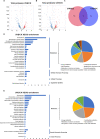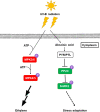Integrative Proteomic and Phosphoproteomic Analyses Revealed the Regulatory Mechanism of the Response to Ultraviolet B Stress in Clematis terniflora DC
- PMID: 36643485
- PMCID: PMC9835548
- DOI: 10.1021/acsomega.2c07258
Integrative Proteomic and Phosphoproteomic Analyses Revealed the Regulatory Mechanism of the Response to Ultraviolet B Stress in Clematis terniflora DC
Abstract
Clematis terniflora DC. (C. terniflora) has been used as an ancient Chinese traditional herbal medicine. The active substances in C. terniflora have been confirmed to be effective in treating diseases such as prostatitis. UV light radiation is a common environmental factor that damages plants and influences primary and secondary metabolism. Previous studies showed that ultraviolet B (UV-B) radiation followed by dark stress resulted in the accumulation of secondary metabolites in C. terniflora leaves. An in-depth understanding of how C. terniflora leaves respond to UV-B stress is crucial for improving C. terniflora value. Here, we conducted label-free proteomic and phosphoproteomic analyses to explore the protein changes under UV-B and UV-B combined with dark treatment. A total of 2839 proteins and 1638 phosphorylated proteins were identified. Integrative omics revealed that the photosynthetic system and carbohydrate balance were modulated under both stresses. The phosphoproteomic data indicated that the mitogen-activated protein kinase signaling pathway was triggered, while the abundance of phosphorylated proteins related to osmotic stress was increased under UV-B stress. Differentially abundant phosphoproteins from UV-B followed by dark treatment were mainly enriched in response to stimulus including calcium-mediated proteins. This study provides new insight into the impact of UV-B stress on C. terniflora and plant molecular resistance mechanisms through proteomic and phosphoproteomic analyses.
© 2022 The Authors. Published by American Chemical Society.
Conflict of interest statement
The authors declare no competing financial interest.
Figures








References
-
- Tao M.; Zhu W.; Han H.; Liu S.; Liu A.; Li S.; Fu H.; Tian J. Mitochondrial proteomic analysis reveals the regulation of energy metabolism and reactive oxygen species production in Clematis terniflora DC. leaves under high-level UV-B radiation followed by dark treatment. J. Proteomics 2022, 254, 104410.10.1016/j.jprot.2021.104410. - DOI - PubMed
-
- Chen R. Z.; Cui L.; Guo Y. J.; Rong Y. M.; Lu X. H.; Sun M. Y.; Zhang L.; Tian J. K. In vivo study of four preparative extracts of Clematis terniflora DC. for antinociceptive activity and anti-inflammatory activity in rat model of carrageenan-induced chronic non-bacterial prostatitis. J. Ethnopharmacol. 2011, 134, 1018–1023. 10.1016/j.jep.2011.01.004. - DOI - PubMed
LinkOut - more resources
Full Text Sources
Molecular Biology Databases

